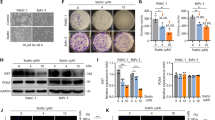Abstract
Differentiation-inducing factor-1 (DIF-1) is a chlorinated hexaphenone isolated from Dictyostelium. DIF-1 exhibits antitumor activity in several types of mammalian tumor cells, although the underlying mechanisms remain unknown. On the other hand, recent studies indicate that constitutively activated STAT3 acts as an oncogene and could be a target for antitumor drug. In the present study, we examined the effects of DIF-1 on proliferation of gastric cancer cell lines as well as on its signal transduction pathways, focusing mainly on STAT proteins. DIF-1 inhibited proliferation of gastric cancer cells. Western blot analysis and electrophoretic mobility shift assay showed that DIF-1 inhibited STAT3 activity in an MEK-ERK-dependent manner in gastric cancer cell lines, AGS and MKN28. Moreover, blockade of STAT3 activity by ectopic expression of dominant-negative STAT3 or the Janus kinase inhibitor, tyrphostin AG490, inhibited cell growth of AGS cells. These results suggest that STAT3 activity plays an important role for cell growth in AGS cells, and raises the possibility that inhibition of STAT3 activity is one of the mechanisms responsible for the antitumor effect of DIF-1 in these cells.
This is a preview of subscription content, access via your institution
Access options
Subscribe to this journal
Receive 50 print issues and online access
$259.00 per year
only $5.18 per issue
Buy this article
- Purchase on Springer Link
- Instant access to full article PDF
Prices may be subject to local taxes which are calculated during checkout





Similar content being viewed by others
References
Asahi K, Sakurai A, Takahashi N, Kubohara Y, Okamoto K and Tanaka Y . (1995). Biochem. Biophys. Res. Commun., 208, 1036–1039.
Bromberg JF, Wrzeszczynska MH, Devgan G, Zhao Y, Pestell RG, Albanese C and Darnell JE . (1999). Cell, 98, 295–303.
Burke WM, Jin X, Lin HJ, Huang M, Liu R, Reynolds RK and Lin J . (2001). Oncogene, 20, 7925–7934.
Chung J, Uchida E, Grammer TC and Blenis J . (1997). Mol. Cell. Biol., 17, 6508–6516.
Darnell JE . (1997). Science 277, 1630–1635.
Garcia R, Bowman TL, Niu G, Yu H, Minton S, Muro-Cacho CA, Cox CE, Falcone R, Fairclough R, Parsons S, Laudano A, Gazit A, Levitzki A, Kraker A and Jove R . (2001). Oncogene, 20, 2499–2513.
Gollob JA, Schnipper CP, Murphy EA, Ritz J and Frank DA . (1999). J. Immunol., 162, 4472–4481.
Gonzalez FA, Raden DL and Davis RJ . (1991). J. Biol. Chem., 266, 22159–22163.
Grandis JR, Drenning SD, Chakraborty A, Zhou MY, Zeng Q, Pitt AS and Tweardy DJ . (1998) J. Clin. Invest., 102, 1385–1392.
Ihle JN . (1996). Cell, 84, 331–334.
Ishiyama M, Miyazono Y and Sasamoto K . (1997). Talanta, 44, 1299–1305.
Jain N, Zhang T, Fong SL, Lim CP and Cao X . (1998). Oncogene., 17, 3157–3167.
Kawata T, Shevchenko A, Fukuzawa M, Jermyn KA, Totty NF, Zhukovskaya NV, Sterling AE, Mann M and Williams JG . (1997). Cell, 89, 909–916.
Kubohara Y . (1997). Biochem. Biophys. Res. Commun., 236, 418–422.
Kubohara Y and Hosaka K . (1999). Biochem. Biophys. Res. Commun., 263, 790–796.
Kubohara Y, Saito Y and Takemoto K . (1995). FEBS Lett., 359, 119–122.
Lim CP and Cao X . (1999). J. Biol. Chem., 274, 31055–31061.
Meydan N, Grunberger T, Dadi H, Shahar M, Arpaia E, Lapidot Z, Leeder JS, Freedman M, Cohen A, Gazit A, Levitzki A and Roifman CM . (1996). Nature, 379, 645–648.
Morris HR, Taylor GW, Masento MS, Jermyn KA and Kay RR . (1987). Nature, 328, 811–814.
Nakajima K, Yamanaka Y, Nakae K, Kojima H, Ichiba M, Kiuchi N, Kitaoka T, Fukada T, Hibi M and Hirano T . (1996). Embo. J., 15, 3651–3658.
Neugut AI, Hayek M and Howe G . (1996). Semin. Oncol., 23, 281–291.
Ni Z, Lou W, Leman ES and Gao AC . (2000). Cancer. Res., 60, 1225–1228.
Nielsen M, Kaltoft K, Nordahl M, Ropke C, Geisler C, Mustelin T, Dobson P, Svejgaard A and Odum N . (1997). Proc. Natl. Acad. Sci. USA, 94, 6764–6769.
Niu G, Shain KH, Huang M, Ravi R, Bedi A, Dalton WS, Jove R and Yu H . (2001). Cancer Res., 61, 3276–3280.
Sartor CI, Dziubinski ML, Yu CL, Jove R and Ethier SP . (1997). Cancer Res., 57, 978–987.
Sengupta TK, Talbot ES, Scherle PA and Ivashkiv LB . (1998). Proc. Natl. Acad. Sci. USA, 95, 11107–11112.
Turkson J and Jove R . (2000). Oncogene, 19, 6613–6626.
Vinkemeier U, Cohen SL, Moarefi I, Chait BT, Kuriyan J and Darnell JE . (1996). Embo. J., 15, 5616–5626.
Wen Z, Zhong Z and Darnell JE . (1995). Cell, 82, 241–250.
Yu CL, Meyer DJ, Campbell GS, Larner AC, Carter-Su C, Schwartz J and Jove R . (1995). Science, 269, 81–83.
Zhang X, Blenis J, Li HC, Schindler C and Chen-Kiang S . (1995). Science, 267, 1990–1994.
Acknowledgements
We thank Dr Eri Iwai-Kanai for her valuable support. This work was supported by a Grant-in-Aid for Scientific Research from the Ministry of Culture and Science of Japan (11370130, 11877090, and 11670496) and a Grant-in-Aid for Research for the Future Program from the Japanese Society for the Promotion of Science (No. JSPS-RFTF97100201).
Author information
Authors and Affiliations
Corresponding author
Rights and permissions
About this article
Cite this article
Kanai, M., Konda, Y., Nakajima, T. et al. Differentiation-inducing factor-1 (DIF-1) inhibits STAT3 activity involved in gastric cancer cell proliferation via MEK-ERK-dependent pathway. Oncogene 22, 548–554 (2003). https://doi.org/10.1038/sj.onc.1206109
Received:
Revised:
Accepted:
Published:
Issue Date:
DOI: https://doi.org/10.1038/sj.onc.1206109
Keywords
This article is cited by
-
STAT3 transcription factor as target for anti-cancer therapy
Pharmacological Reports (2020)
-
Loss of AF-6/afadin induces cell invasion, suppresses the formation of glandular structures and might be a predictive marker of resistance to chemotherapy in endometrial cancer
BMC Cancer (2015)
-
Characterization and identification of PARM-1 as a new potential oncogene
Molecular Cancer (2013)
-
Differentiation-inducing factor-1 enhances 5-fluorouracil action on oral cancer cells inhibiting E2F1 and thymidylate synthase mRNAs accumulation
Cancer Chemotherapy and Pharmacology (2012)
-
Effects of dasatinib on EphA2 receptor tyrosine kinase activity and downstream signalling in pancreatic cancer
British Journal of Cancer (2008)



